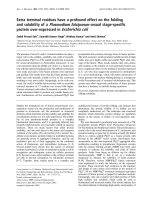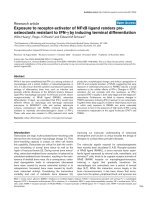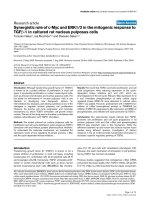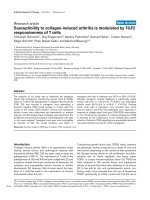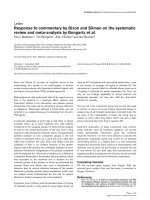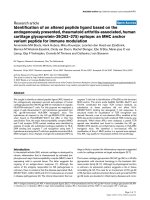Báo cáo y học: "Response to commentary by Dixon and Silman on the systematic review and meta-analysis by Bongartz et al" doc
Bạn đang xem bản rút gọn của tài liệu. Xem và tải ngay bản đầy đủ của tài liệu tại đây (31.35 KB, 2 trang )
Page 1 of 2
(page number not for citation purposes)
Available online />Dixon and Silman [1] provide an insightful review of the
methodology and results of our meta-analysis of harmful
events among patients with rheumatoid arthritis treated with
anti-tumour necrosis factor (TNF) antibody agents [2].
Meta-analyses of valid randomized trials of like agents ensure
that, in the absence of a treatment effect, patients with
rheumatoid arthritis in the intervention and placebo groups
should share the same risk for developing serious infections
or malignancy. Etanercept, although it needs study, was not
included in our analysis because it is dissimilar from the anti-
TNF agents.
A particular advantage of such trials is that there is almost
complete follow up of each treatment arm, with patients
maintained in the assigned groups for intent-to-treat analysis
at least for the randomized portion of the trial, even if drug
exposure is discontinued for whatever reason. The appropriate
statistical analysis of such comparator groups in the trial
context of equivalent follow up in each arm is an odds ratio
rather than incidence rate ratio. Dixon and Silman raise the
possibility of bias in our analysis because of the greater
dropout rate in the placebo arm, potentially leading to a lower
detection threshold for malignancies in the placebo compared
with the treatment arm. We found no evidence for a difference
in detection thresholds in the placebo follow-up period, which
was equivalent to the treatment arm in duration for the
controlled phase of the studies on which we performed the
analysis. Dixon and Silman also note a classification or
detection bias for serious infections because of the greater
likelihood of placebo patients being hospitalized. In this case
our analysis would underestimate the true risk for serious
infection in treated compared with control patients.
In practice, lack of efficacy with the standard dose of 3 mg/kg
of infliximab results in many patients using higher doses; as
many as 61% of patients with rheumatoid arthritis after 1 year
of use receive, on average, 4.9 mg/kg of infliximab [3]. The
manufacturer’s product label for infliximab allows doses up to
10 mg/kg of infliximab for partial responders [4]. Thus, not
only are our findings applicable to clinical practice and
biologically plausible, but they also fulfill the dose-effect
criterion for causality.
The low risk in the comparison group may be real, the result
of chance, or due to an as yet unclear systematic design or
analysis flaw of all included randomized controlled trials. We
are wary of the interpretation of lower risk being due to
chance or some other drug effect, which may give a false
sense of security about the drug in question [5].
Long-term observation of large, unselected case cohorts,
using methods such as treatment registries will provide
widely generalizable information about the treatment
response. However, it is even more difficult to compose the
appropriate comparator group and control for all potential
confounding factors in a registry than in a well conducted
randomized clinical trial. Early conduct of meta-analyses with
methods, such as those we put forward, to estimate the rate
of rare events [2] can yield data that manufacturers and
regulatory bodies, and patients and clinicians should consider
when making policy and clinical decisions, respectively.
Competing interests
TB has received grant support from Amgen. ELM has
received grant support from and has been a consultant to
Amgen, Centocor.
References
1. Dixon W, Silman A: Is there an association between anti-TNF
monoclonal antibody therapy in rheumatoid arthritis and risk
of malignancy and serious infection? Commentary on the
meta-analysis by Bongartz et al. Arthritis Res Ther 2006, 8:111.
Letter
Response to commentary by Dixon and Silman on the systematic
review and meta-analysis by Bongartz
et al
.
Eric L Matteson
1
, Tim Bongartz
1
, Alex J Sutton
2
and Iain Buchan
3
1
Division of Rheumatology, Mayo Clinic College of Medicine, Rochester, Minnesota, USA
2
Department of Health Sciences, University of Leicester, Leicester, UK
3
Northwest Institute for Bio-Health Informatics, University of Manchester, Manchester, UK
Corresponding author: Eric L Matteson,
Published: 1 September 2006 Arthritis Research & Therapy 2006, 8:404 (doi:10.1186/ar2033)
This article is online at />© 2006 BioMed Central Ltd
See related commentary by Dixon and Silman, />Page 2 of 2
(page number not for citation purposes)
Arthritis Research & Therapy Vol 8 No 5 Matteson et al.
2. Bongartz T, Sutton AJ, Sweeting MJ, Buchan I, Matteson EL,
Montori V: Anti-TNF antibody therapy in rheumatoid arthritis
and the risk of serious infections and malignancies. Systemic
review and meta-analysis of rare harmful effects in random-
ized controlled trials. JAMA 2006, 295:2275-2286.
3. Stern R, Wolfe F: Infliximab dose and clinical status: results of
2 studies in 1642 patients with rheumatoid arthritis. J Rheuma-
tol 2004, 31:1538-1545.
4. Remicade label information [ />hcp/hcp_PI.jsp]
5. Lagakos SW: Time-to-event analyses for long-term treat-
ments: The APPROVe trial. N Engl J Med 2006, 355:113-117.
